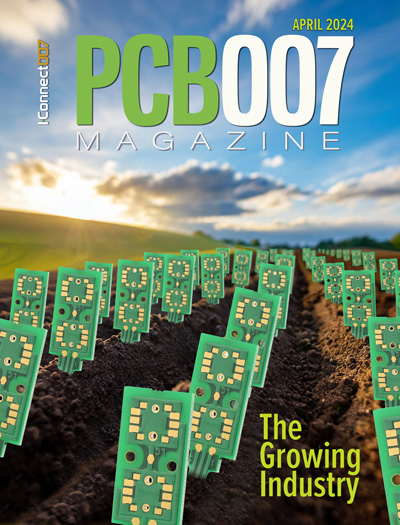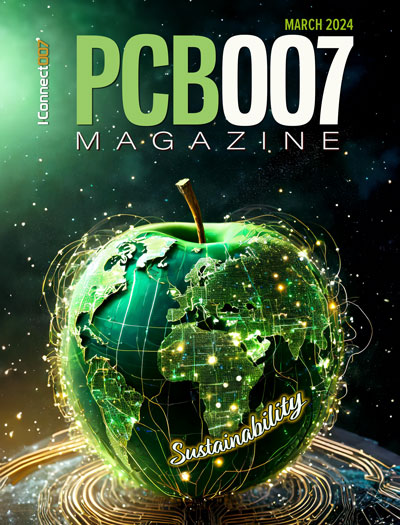-

- News
- Books
Featured Books
- pcb007 Magazine
Latest Issues
Current Issue
The Growing Industry
In this issue of PCB007 Magazine, we talk with leading economic experts, advocacy specialists in Washington, D.C., and PCB company leadership to get a well-rounded picture of what’s happening in the industry today. Don’t miss it.

The Sustainability Issue
Sustainability is one of the most widely used terms in business today, especially for electronics and manufacturing but what does it mean to you? We explore the environmental, business, and economic impacts.

The Fabricator’s Guide to IPC APEX EXPO
This issue previews many of the important events taking place at this year's show and highlights some changes and opportunities. So, buckle up. We are counting down to IPC APEX EXPO 2024.
- Articles
- Columns
Search Console
- Links
- Events
||| MENU - pcb007 Magazine
Isola Releases IS550H Material
April 26, 2021 | Nolan Johnson, I-Connect007Estimated reading time: 2 minutes
Nolan Johnson speaks with Michael Gay of Isola and Chris Hunrath of Insulectro about the release of their new halogen-free, high-thermal reliability material, which they hope fills the gap in the market between epoxies and polyimides.
Nolan Johnson: I understand there’s something new on the market for us to talk about. Why don’t you tell us what it is and what the application is?
Michael Gay: Quite a few years ago, the automotive industry OEMs were looking for an alternative to ceramic-based materials for high temperature applications. They wanted something that was less costly. They wanted something that would fill in the gap between typical FR-4 applications and ceramics. A consortium called The Help Project was developed with several large OEMs and other industry participants in the automotive sector who wanted to work together and develop this material. We started with about a half-dozen different candidates and then whittled it down, making comparison to products like 370HR, which is a typical FR-4 lead-free compatible material. We started doing evaluations and we came up with the product we now call IS550H.
Johnson: And this is a new product?
Gay: Yes, it’s brand new. We launched this product about four or five weeks ago. The product is manufactured in Asia. It’s really directed toward the automotive industry, but because of the properties of the material, it can actually be applied to other industries where high temperatures and high voltage CAF performance are required.
Johnson: From the automotive application perspective, how is this a response to the demands of OEMs?
Chris Hunrath: High-speed charging is an obvious area of concern, and one of the ways you accomplish that is using higher voltage. You need something with very good dielectric properties. Epoxy is good, but this material is better. Rapid charging drives this heavy copper requirement as well as the ability to make circuits and embed them in the dielectric material. With thermal performance, in the organic substrates, it has always been the domain of polyimide, with epoxies, multifunctional epoxies, and some materials in between. But there was a space between polyimide and epoxy, and we knew that polyimide doesn’t do certain things very well. It absorbs moisture, but it gets brittle as it cures. It is very decomposition resistant, but it does have some other drawbacks.
As Michael mentioned, ceramics are very good in certain applications for high temperature, but you can’t do everything you want to do in circuitry in ceramics that you can easily do with a PCB material or organic PCB material. This just gives the engineers and designers a whole lot of options when they’re designing circuits. The base resin chemistry (I don’t believe it’s proprietary) is something called benzoxazine, and it’s a newer resin system. It’s been around for a long time, but it’s newer than epoxy. The way it cross-links and the way it behaves in high temperature applications is different. It has actually been used in aircraft bodies. You’ve heard the airline industry is moving away from aluminum parts to composite parts. Well, this is the resin that is being used. Resin has to be able to flow and fill large features very well, but it also has to withstand temperature variations. Think of an aircraft on the runway vs. an aircraft in the upper atmosphere—we see some pretty wide temperature changes. This resin chemistry does all those things very well.
To read this entire interview, which appeared in the April 2021 issue of PCB007 Magazine, click here.
Suggested Items
Designer’s Notebook: What Designers Need to Know About Manufacturing, Part 2
04/24/2024 | Vern Solberg -- Column: Designer's NotebookThe printed circuit board (PCB) is the primary base element for providing the interconnect platform for mounting and electrically joining electronic components. When assessing PCB design complexity, first consider the component area and board area ratio. If the surface area for the component interface is restricted, it may justify adopting multilayer or multilayer sequential buildup (SBU) PCB fabrication to enable a more efficient sub-surface circuit interconnect.
Insulectro’s 'Storekeepers' Extend Their Welcome to Technology Village at IPC APEX EXPO
04/03/2024 | InsulectroInsulectro, the largest distributor of materials for use in the manufacture of PCBs and printed electronics, welcomes attendees to its TECHNOLOGY VILLAGE during this year’s IPC APEX EXPO at the Anaheim Convention Center, April 9-11, 2024.
ENNOVI Introduces a New Flexible Circuit Production Process for Low Voltage Connectivity in EV Battery Cell Contacting Systems
04/03/2024 | PRNewswireENNOVI, a mobility electrification solutions partner, introduces a more advanced and sustainable way of producing flexible circuits for low voltage signals in electric vehicle (EV) battery cell contacting systems.
Heavy Copper PCBs: Bridging the Gap Between Design and Fabrication, Part 1
04/01/2024 | Yash Sutariya, Saturn Electronics ServicesThey call me Sparky. This is due to my talent for getting shocked by a variety of voltages and because I cannot seem to keep my hands out of power control cabinets. While I do not have the time to throw the knife switch to the off position, that doesn’t stop me from sticking screwdrivers into the fuse boxes. In all honesty, I’m lucky to be alive. Fortunately, I also have a talent for building high-voltage heavy copper circuit boards. Since this is where I spend most of my time, I can guide you through some potential design for manufacturability (DFM) hazards you may encounter with heavy copper design.
Trouble in Your Tank: Supporting IC Substrates and Advanced Packaging, Part 5
03/19/2024 | Michael Carano -- Column: Trouble in Your TankDirect metallization systems based on conductive graphite or carbon dispersion are quickly gaining acceptance worldwide. Indeed, the environmental and productivity gains one can achieve with these processes are outstanding. In today’s highly competitive and litigious environment, direct metallization reduces costs associated with compliance, waste treatment, and legal issues related to chemical exposure. What makes these processes leaders in the direct metallization space?


